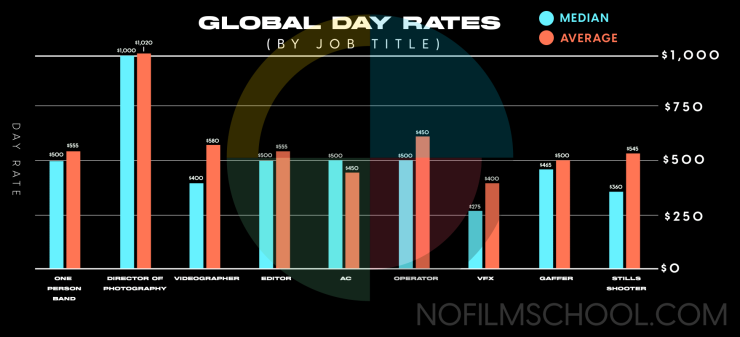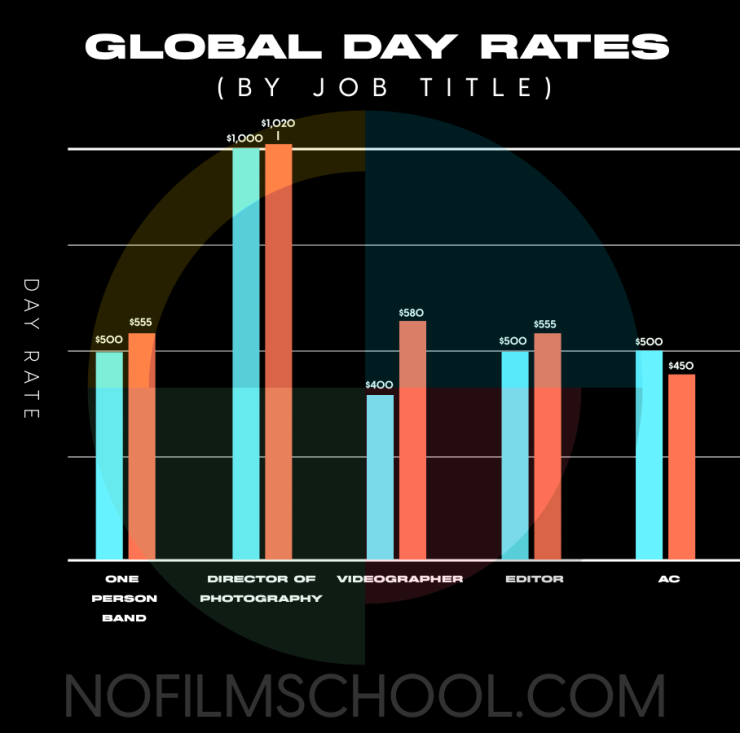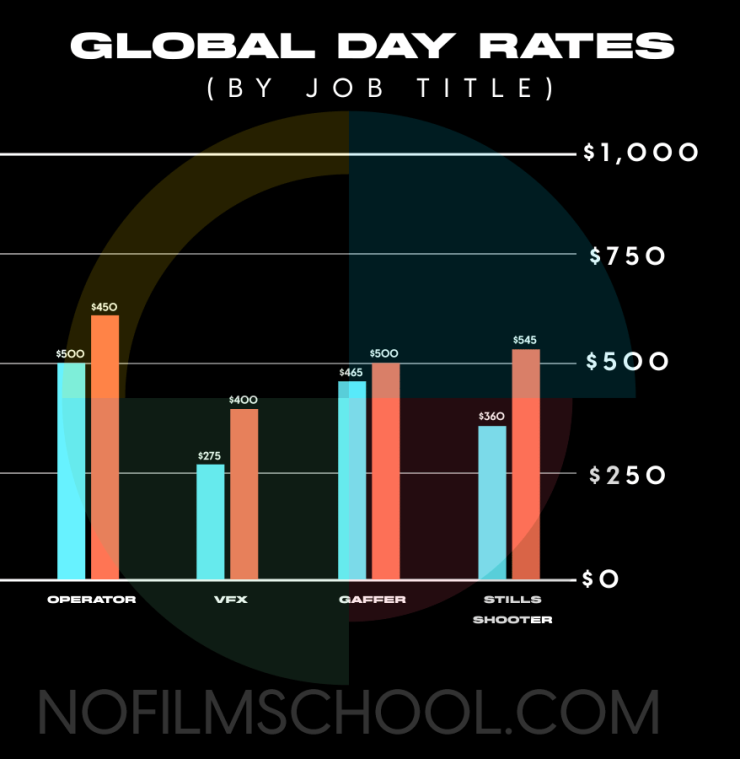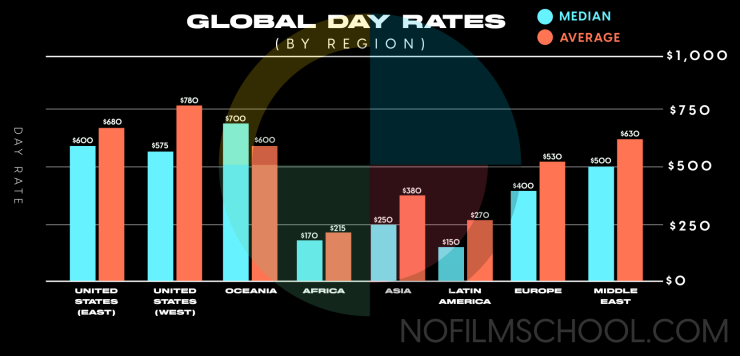
Are you being paid enough for your video or film work? How much are others charging, and how much should you?
Last year No Film School conducted a survey of cinematographers around the world. Over two thousand of you responded—thank you!—and as a result it took us quite some time to compile and analyze the data. The results are finally in!
We surveyed DPs, videographers, and editors in every region of the world to give you valuable insight into what others are being paid.
The results can help you know what to charge — and can help you negotiate with clients.
Table 1: Global Day Rates (By Job Title)
First we'll take a look at global rates by job title, separated into average and median quotes. Whether you're a solo creative doing everything under the sun or focus on an individual discipline, this table will give you a clear understanding of what creatives are charging around the world. Here are the global day rates by job title:

There's a lot to take in here, so let's zoom in on left side and take a look at the day rates of One Person Bands, Directors of Photography, Videographers, Editors, and ACs:

Zooming in on the right side, to Operators, VFX artists, Gaffers, and Still Shooters:

Day rates for these other roles come in $300-500 a day, globally.
While this graph alone won't be the answer to the all-important question of what you should charge, it's a great baseline to compare day rates among different roles within the industry. If you're just starting your career and don't know what to focus on, seeing how the different day rates compare may give you some direction...
But, of course, rates vary greatly by region of the world. Which is where our next table comes in...
Table 2: Global Day Rates (By Region)
This graph helps further clarify things. In this table, we've broken down our survey results by region instead of by job title. There are robust video and film industries all around the world, but rates (in US dollars) vary greatly. We tallied our survey responses by every region in the world, splitting the United States into two regions, East and West. Here are the results:

With all job titles averaged together, the United States led the way in average day rate, with a median of around $600/day, and a slightly higher average. The reason we include both median and average numbers is as follows: sometimes a small number of respondents making very high rates can bring the average up in a way that isn't particularly instructive for your "average" worker... which is where the median numbers come in. The median numbers reflect a more "common" rate, throwing out the outliers.
Day rates don't tell the full story, of course — cost of living varies greatly by region, as well. But these regional numbers can help you know how rates stack up around the world, and what the average video worker is charging in your own region.
In these graphs, what results surprised you? Does anything look "off?" Let us know. These are by no means perfect numbers, and in some regions we received fewer results than others, making small sample sizes less instructive. But we hope these numbers are useful.
Where To Go From Here?
We've put together an even more valuable analysis of these results so that you can know exactly what how much others are making at your specific job AND in your specific region. Think of it as a supercharged version of the results above, packaged together with insights that will help you know what to charge — and how to negotiate with clients.
Announcing our first in-depth online course, How to Make Money as a Cinematographer!
Visit the Course Page to Learn More
Our goal with these survey results was to give you valuable insights into how your own day rate stacks up against other video workers. No Film School has always strived to empower creatives in film, video, and beyond. Join us now to take your career — and your day rate — to the next level.
Your Comment
11 Comments
I would like to see other departments (audio, hair/make up) added to this survey, as they are critical to most shoots and part of the production budget.
January 5, 2023 at 3:21PM
I think this info needs to clarify that the rates are not including all the necessary gear (camera, lights, sound, etc.) and is the rate for the qualified person only.
As a film DP may have their own gear, along with other departments, a videographer typically has to have all./most of their own gear, so the charts do not reflect that.
Minor point, but a financially notable one, IMO.
January 5, 2023 at 3:45PM
Worth talking about but I think it's also important to remember that the kit fee is purely to offset the cost of gear ownership. So none of that money is really going in your pocket
January 13, 2023 at 1:42AM
You should definitely be charging enough for kit/rentals to make a profit off of the equipment, not just to cover the cost. 15%-20% markup at least. If not, you're leaving money on the table and preventing yourself from saving for wear and tear, repairs and for future equipment investing.
Personally, as a one-man-band I build my standard kit fee into my day rate and only itemize for special equipment.
January 16, 2023 at 8:22AM
Editors are underpaid. Why would an editor and an AC make the same amount? An editor has more influence on a project than anyone after a producer, director, and a DP. Editors not only have to know their craft, but they are often expected to interact with agencies, executives and so on. An editor can make mediocre footage sing or ruin fantastic footage. They fate of every project is in the editor's hands. They have tremendous influence. It's absurd. I suspect the reason is that editors are just seen as people working on a computer...and tech devalues everything.
I imagine the same will happen to DPs soon. As virtual production takes over and more and more shots are really created in post, DPs will be seen a raw data gatherers and their rates will drop. If you are a DP, I bet your rates will drop in half in the next 5-10 years.
January 5, 2023 at 6:58PM, Edited January 5, 7:02PM
Heck, look at the VFX rates. They're basically editors on steroids yet they get paid even less. I thought I was under charging for my 'one man band' company but apparently I'm charging almost double?! And the still shooter seems way off. We hired one for just headshots - $2,000 for about 15 snaps and a group shot. I guess it all comes down to charging what you feel you're worth and letting others decide whether they agree.
January 6, 2023 at 9:25AM
humm...just my 2 cents, but if you think you can hire a decently skilled person in any of these disciplines for $30-$50 per hour (developed countries) you are dreaming. The missing key here is you took a survey ... your data set is flawed ....
January 6, 2023 at 10:52AM
These charts are incredibly flawed. Like Grant mentioned, they do not take into consideration the cost of gear (or insurance, opening a LLC, paying taxes, etc.) and the author does not make a point to address this.
The individual job earnings should have been broken out by region/country (i.e. this is how much an editor makes in the U.S.). An editor based in Afghanistan on Fiverr is going to drastically reduce the average on those global numbers, just like the high-earners in LA would (the author points out the latter but not the former).
Lastly, the industry in which respondents worked in is not noted on the results. Is the "videographer" working in corporate, events, or news? An event videographer will probably score a rate on the low-end of the scale but a corporate videographer would earn drastically more money per day.
Without the above context, these numbers will only knee-cap budding videographers/editors/one-person-bands/whatever. They will think these are the numbers to charge when they could probably charge a lot more for their services.
January 7, 2023 at 3:55AM, Edited January 7, 3:57AM
this information is fantastic. years of visiting this site and this is easily the greatest tool thus far
January 8, 2023 at 9:30AM
Absolutely useless for anyone trying to get a grasp of rates. The positional rates are global average and median and the regional rates are of all positions put together. Who thought this would paint any kind of meaningful picture?
January 10, 2023 at 2:46AM, Edited January 10, 2:47AM
Knowing what to charge during a start up is difficult. Factoring everything one finds they are torn between greed and reality. With that said, you don't want to give the farm away and you don't want your client to feel like they have been robbed. That sweet spot doesn't come easy. Thank you for this survey, it helps put things into focus. I am currently taking on a new platform, starting a new business using drones. Folks think it as a toy and forget that its pricing should reflect photography and video rates, as well as, the cost of aerial work. Thanks again.
January 12, 2023 at 7:55AM